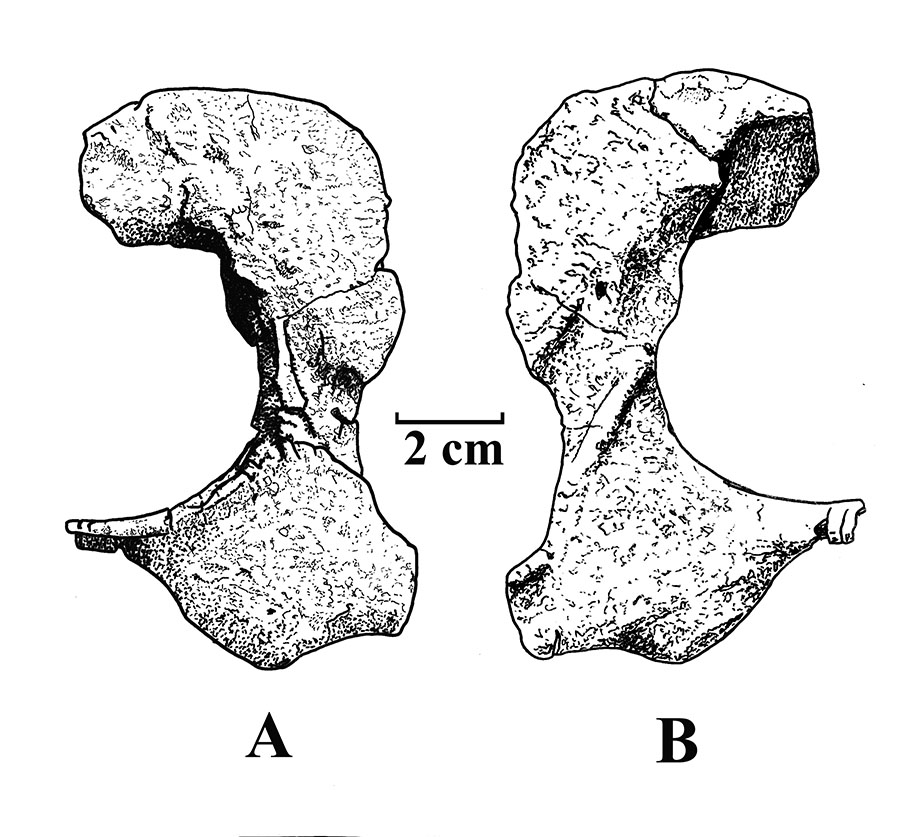
Genus: Hungarosaurus OSI, 2005
Etymology: In reference to the country of Hungary, where the specimens where
found.
= Genus: Nova OSI, 2002
Species: tormai OSI, 2005
Etymology: In honor of Andras Torma with whom the locality was discovered.
Holotype: MTM 2007.26.1-2007.26.34, 2007.89.1, 2007.89.2 (originally MTM Gyn404)
Locality: Iharkut, Veszprem County, Bakony Mountains, Transdanubian Range, western Hungary.
Horizon: Csehbanya Formation.
Biostratigraphy:
Age: Santonian Stage, Senonian Subepoch, Gulf Epoch, Late Cretaceous.
Material: Premaxilla with 1 tooth, left lacrimal, left prefrontal, right postorbital, jugal and quadratojugal, left frontal, vomer, pterygoid, right quadrate, part of the left quadrate, basioccipital, 21 isolated teeth, 1 hyoid bone, anterior part of the dentary, surangular, angular, small posterior part of the dentary, 3 cervical vertebrae, 6 dorsal vertebrae, 10 caudal vertebrae, 3 cervical and 13 dorsal ribs, 5 chevrons, some tendon fragments, complete left scapulocoracoid, right scapula and anterior part of the right coracoid, right radius with 4 metacarpals, preacetabular parts of the left and right ilia, left ischium, right femur, right fibula, and more than a hundred osteoderms.

Orbital rim, A) lateral and D) medial views (after ŐSI, RABI, MAKADI, SZENTESI, BOTFALVAI & GULYAS, 2012)
Paratypes:
MTM 2007.22.1 (originally MTM Gyn/405): 1 anterior dorsal vertebra, cervical and dorsal ribs, 1 half-ring osteoderm, some small circular osteoderms.
MTM 2007.24.1-2007.26.10 (originally MTM Gyn/406): Fragmentary ulna, distal end of a femur?, one metapodium, fragmentary ribs and osteoderms.
MTM 2007.23.1-2007.23.5, 2007.90.1, 2007.90.2 (originally MGM Gyn/407): Sacrum with sacral rod, left ilium, right fragmentary ilium, left and right ischia, sacral fused osteoderms.
Referred material:
Hungarosaurus tormai (modified from ŐSI, 2005), composite skull.
ŐSI & MAKADI, 2007, 2009
MTM 2007.25.1-2007.25.30: Left mandible, right dentary, several dorsal and caudal vertebrae, the sacrum without sacral rod, cervical and dorsal ribs, paravertebral elements, left scapulocoracoid, right humerus, both ulnae, ?right radius, four metacarpals, both ilia, right ischium, both femora, left fibula, four metatarsals, two phalanges, one ungual phalanx, three cervical half-ring osteoderms and several oval, circular or lance-shaped osteoderms.
MTM V.2003.12: Premaxilla-maxilla fragment.
MTM 2007.26.3: Left fragmentary postorbital.
ŐSI, PEREDA-SUBERBIOLA & FÖLDES, 2014
PAL 2013.23.1: Partial skull and endocast.
ŐSI, BOTFALVAI, ALBERT & HAJDU, 2019
MTM V2010.1.1: Postorbital region.
MTM V2010.1.1: Orbital rim, A) lateral and D) medial views (after ŐSI, RABI, MAKADI, SZENTESI, BOTFALVAI & GULYAS, 2012)
MTM 2007.28.1: Left fragmentary postorbital.
MTM 2007.28.1:Orbital rim, A) lateral and D) medial views (after ŐSI, RABI, MAKADI, SZENTESI, BOTFALVAI & GULYAS, 2012)
MTM VER 2017.66, 2016.578, 206.578: Boomerang shaped central osteoderm fragments with conical spikes.
ŐSI, BOTFALVAI, ALBERT & HAJDU, 2019, ŐSI & PEREDA-SUBERBIOLA, 2020
MTM PAL 2016.16.1: 3 relatively large, ossified fragments of pelvic armor in associated skeleton.
ŐSI, MAGYAR, ROSTA & VICKARYOUS, 2021
MTM PAL 2020.31.1: Partial skull with most of the rostrum including the premaxillae, nasals, the right fragmentary maxilla and the right frontal-supraorbital-?prefrontal-?lacrimal.
MTM PAL 2020.32.1: Partial skull including the partial basicranium, most of the skull roof (frontal, postfrontal, parietal) between and behind the orbits, the two nasals, the left postorbital, left squamosal, most of the leff quadrate and distal end of the right quadrate.
MTM PAL 202o.33.1: Isolated left premaxilla.
MTM PAL 2020.34.1: Isolated right nasal.